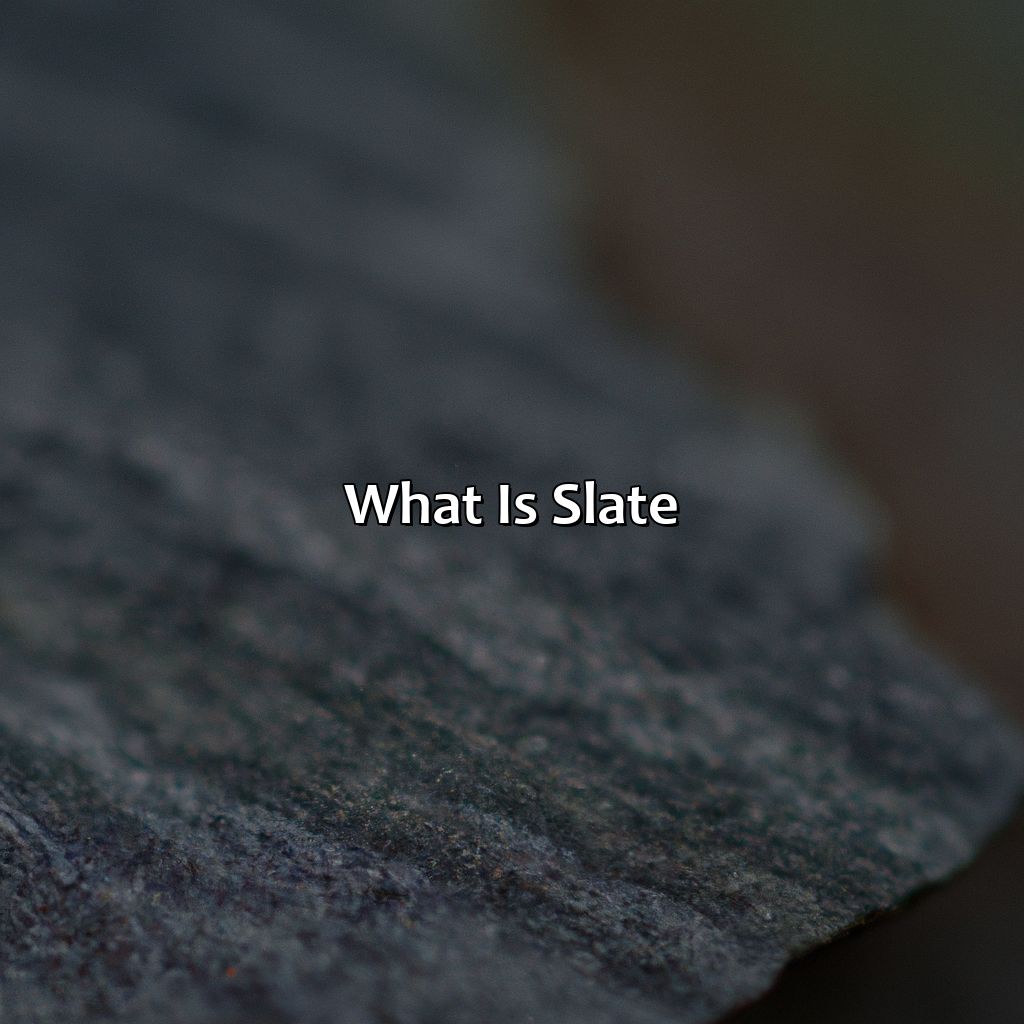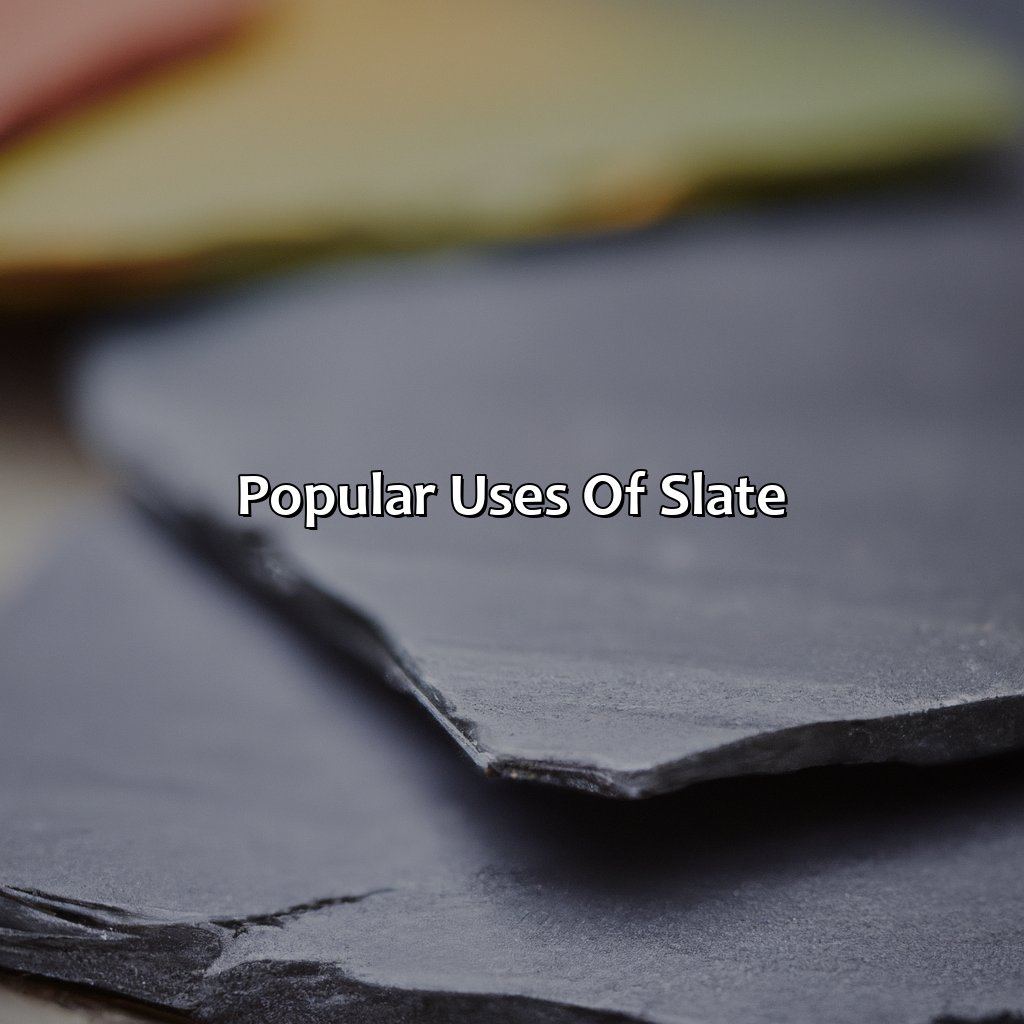##Key Takeaways:
Key Takeaway:
- Slate is a natural stone that is mined from quarries and used in various industries, including construction, interiors, fashion, and technology.
- Slate comes in a variety of colors, including slate gray, slate blue, slate black, and slate green, which are influenced by geographical factors such as the environment and climate, as well as chemical composition and impurities.
- Slate is used for roofing, flooring, and decorative purposes, and requires proper maintenance and cleaning to ensure durability and sustainability.
What is Slate

Photo Credits: colorscombo.com by Eugene Scott
Slate is a natural stone that has been formed through geological processes. It is commonly used in construction, particularly for roofing and flooring due to its durability and resistance to water absorption. Slate is mined from quarries in various regions around the world and the production process involves a number of steps to refine the quality of the harvested stone.
The slate industry is an important segment of the mining and trade markets, as it offers a range of high-quality products that are used in various construction projects. The production of slate involves the careful extraction and refinement of natural stone, which is then cut and shaped to meet the requirements of different applications. The prices of slate products are determined by factors such as supply and demand, as well as the quality of the stone being harvested.
One unique aspect of the slate industry is its focus on sustainability and responsible mining practices. Many companies involved in the production and trade of slate have adopted eco-friendly policies designed to minimize the impact of their activities on the environment. This includes using renewable energy sources and implementing waste reduction measures throughout the production process.
In the early 1900s, slate was a booming industry in the Welsh region of the United Kingdom. The town of Blaenau Ffestiniog was at the center of this industry and it was said that the town’s economy was built on the back of the slate trade. Today, while the industry has experienced a decline in recent years, slate remains an important natural resource that is highly valued for its qualities and versatility.
Colors of Slate

Photo Credits: colorscombo.com by Gerald Young
To grasp the colors of slate, like slate gray, slate blue, slate black, slate green, and slate grey, you need to know why it comes in different shades. Geographical factors, like environment, region, landscape, climate, and variation, can impact the hues of natural stone. Moreover, the chemical composition of slate, including minerals, elements, impurities, and color, affects the stone texture, effect, and finishes.
Geographical Influence on Slate Color
The look of slate is influenced by the geography and environment where it was formed. Factors like the composition of minerals, geographical location, and climate determine the color variation in slate.
Below is an overview table showing how different geographical regions impact the color of slate:
| Geological Location | Color |
|---|---|
| North Wales | Dark Grey/Blue-Black |
| Vermont | Gray-Green |
| Brazil | Green, Blue-Green |
| Spain | Black/Dark Grey |
It’s worth noting that there are other variations depending on specific quarries within these regions, but this table provides a general idea of how geography plays a vital role in determining slate color.
Slate’s colors can also vary due to factors such as mineral content fluctuations or even temperature changes during formation. For instance, in warmer climates like Brazil, some slates develop a green hue due to increased amounts of chlorite minerals.
Finally, it is important to understand that knowing the origin of your slate will help with replacement and maintenance efforts. For example, if one has Spanish black/dark-grey slate tiles in their home and requires repair work or new installation for any reason, seeking out pieces from that particular region will ensure a uniform look and match in terms of style and color.
Who knew that a little mix of minerals and impurities could create such a colorful chemical composition in slate?
Chemical Composition and Color
The color of slate is determined by various factors, including its chemical composition. The minerals and elements present in the rock are responsible for producing distinct colors. Different impurities within the rock can also lead to variations in color.
A table showcasing the relationship between chemical composition and slate color can provide valuable insight. For example, high levels of iron oxide in slate can produce a red or orange hue. Alternatively, high amounts of magnesium oxide can contribute to a purple or blue coloration.
Furthermore, the mineral makeup of slate can often vary depending on its geographical location. Slate produced in regions such as Vermont or Pennsylvania may have a higher concentration of specific minerals that contribute to its unique coloring.
When selecting slate for decorative purposes or construction projects, it is essential to consider these factors to determine the desired appearance and fit for the specific application.
Pro Tip: Utilize chemical testing and analysis services to determine the exact chemical composition of your selected slate before installation. This information will help ensure its suitability for your intended use and maintain its optimal appearance over time.
Slate: the versatile material that’s perfect for roofing, flooring, and apparently even your entire wardrobe.
Popular Uses of Slate

Photo Credits: colorscombo.com by Noah Green
We will explore how slate is used in roofing, flooring, and for decoration. Roofing uses include shingles, durability, sustainability, and environmental impact. Flooring looks at texture, pattern, leather, furniture, and decor. Decoration covers a range of applications for creating stunning visual effects. Alternatives to slate roofing will also be discussed.
Roofing
Slate roofing is a durable and sustainable option for homeowners. Natural slate shingles can withstand harsh weather conditions, such as snow, hail and high winds. Compared to other roofing materials, slate has a lower environmental impact and can last over a century with proper maintenance. Alternative synthetic roof materials cannot match slate’s strength and longevity.
Slate roofing has been used for centuries, and its popularity continues today because of its durability and beauty. The natural stone variety of slate provides a unique look that can add value to any home or building. Plus, since it is made from natural minerals, it is also eco-friendly when compared to synthetic roofing materials.
In addition to the environmental benefits of slate roofing, there are also cost savings in the long run due to its longevity. While the initial installation may be more expensive than other options like asphalt shingles, in the long run slate is both affordable and favourable.
True History: Slate roofs date back thousands of years and have outlasted generations of buildings across Eastern Europe, Wales, and parts of North America. Welsh quarries were among the first to export slate, and this material remains popular today for use in projects that require high-quality roofing systems.
Step up your interior game with the unique texture and pattern of slate flooring – it’s like adding a touch of leather to your decor without harming any animals.
Flooring
Slate flooring is a popular choice due to its unique texture and pattern. It offers a natural and comfortable feel that complements leather furniture and other home decor. Requiring little maintenance, slate flooring is durable, resistant to stains, and easy to clean. The texture of slate provides excellent slip resistance, making it ideal for high traffic areas such as entryways or kitchens. With the right installation techniques, slate flooring can be an attractive and long-lasting investment in your home.
Pro Tip: Before installation, ensure that the subfloor is level and sturdy to prevent cracking or shifting of the tiles over time.
Looking to add some slate-inspired flair to your home or wardrobe? From bedding to technology, slate is the versatile accent color you never knew you needed.
Decorative Applications
Decorative Enhancements with Slate
Slate is not only a utilitarian material but also an incredible device for cosmetic enhancements. Incorporate slate into your interiors or exterior, from traditional to contemporary, slate can add depth and warmth. Decorative accents include using slate accessories such as trivets, coasters, and platters which provide a modern twist on the classic garden trend, while bedding and curtains create an inviting atmosphere where you can unwind in style. The texture of slate adds extra elegance to carpets or throws, making them perfect for home fashion. Pillows can also receive enhanced quality via slate designs. Beyond the limits of your home decoration, decorative handbags, shoes or watches with layered slate surfaces embody innovation and sophistication.
Going beyond decor alone, unique forms of art and photography featuring geological wonders inspire conversations on environmentalism while adding color and texture to spaces where you relax. Not limited to residential spaces only architectural masterpieces feature this gorgeous classic stone by combining it with technology to produce unique sculptures which are both functional yet artistic.
Pro tip: Consider incorporating contrasting colors in artistic creations using multiple colored slates to yield more dramatic effects in your final product.
Maintaining slate is like keeping a high maintenance lover, but unlike relationships, it’s worth it for its durability, sustainability and minimal environmental impact compared to alternatives.
Maintenance of Slate

Photo Credits: colorscombo.com by Vincent King
For a long-lasting, sustainable slate, you need to take care of it! To keep your slate looking pristine, clean and seal regularly. And if there are any damages, repair them quickly. This will not only improve the slate’s lifespan but also its environmental impact.
Here’s a closer look at these maintenance tasks: cleaning and sealing slate, and repairing slate.
Cleaning and Sealing Slate
Maintaining the pristine condition of slate is crucial to ensure its durability and sustainability. Proper cleaning and sealing of slate can prolong its lifespan, minimize environmental impact, and also prevent it from staining or cracking.
A 4-Step Guide to Cleaning and Sealing Slate:
- Remove any dirt or debris by cleaning the slate surface with warm water mixed with a mild detergent. Avoid using harsh chemicals that may damage the slate’s natural properties.
- Rinse off the soap thoroughly and let it dry for at least 24 hours before sealing.
- Apply a sealant formulated specifically for slate surfaces evenly across the area using a foam roller or lambswool applicator.
- Allow the sealant to absorb into the slate surface and then apply a second coat after approximately 24-36 hours.
It is essential to re-seal your slate every two years or as often as recommended depending on how frequently you use the space. Additionally, there are eco-friendly and more sustainable alternatives to traditional sealants available in the market that would be worth exploring further.
Fun Fact: In ancient times, people used a mixture of beeswax, linseed oil, turpentine, and varnish to protect their slate roofs from harsh weather conditions and extend their lifespan.
Repairing Slate
Here’s a 4-Step Guide for repairing slate:
- Identify the damaged tile(s).
- Remove any loose debris from the surrounding area.
- Carefully remove the damaged tile(s) using a slate ripper or chisel.
- Replace with new or salvaged matching tiles using appropriate adhesives or mortars.
It is important to note that repairs should match the original material as closely as possible to maintain consistency and aesthetic appeal. Additionally, ongoing maintenance efforts such as cleaning and sealing can prevent future damage, reducing the need for repairs.
A unique detail about repairing slate is that it typically requires more time and effort than other materials due to its natural variation in thickness and shape. However, these variations also contribute to its highly desirable appearance.
According to BuildingGreen.com, using synthetic slates made from recycled rubber or plastic can provide an environmentally-friendly alternative to natural slate without sacrificing durability or aesthetics.
In summary, repairing slate is an important aspect of maintenance that contributes to both durability and sustainability. By following proper techniques and considering alternatives, homeowners can enjoy the unique beauty of this natural material for years to come while minimizing environmental impact.
Five Facts About the Color Slate:
- ✅ Slate is a dark gray color with a slight bluish or purplish tinge. (Source: ColorHexa)
- ✅ The term “slate” comes from the rock of the same name, which is often used for roofing, flooring, and other construction purposes. (Source: The Spruce)
- ✅ Slate has been used as a medium for writing and drawing for centuries, particularly in the form of slate tablets or “blackboards.” (Source: Slate Magazine)
- ✅ Slate is a popular color in fashion, often used for clothing, accessories, and home décor. (Source: Vogue)
- ✅ Slate is often associated with feelings of stability, reliability, and sophistication. (Source: Sensational Color)
FAQs about What Color Is Slate
What color is slate?
Slate is a type of rock that comes in many different shades depending on the region it is quarried. Generally, slate is a dark gray color with some variations of blue, green, or brown.
What are some common color variations of slate?
In addition to the dark gray color that is frequently associated with slate, there are many variations of slate that are popular in construction and home decor. Some of the most common color variations of slate include blue, green, black, and brown.
Can slate come in lighter colors?
While slate is generally known for its darker hues, it is possible to find slate in lighter colors. Some varieties of slate can be found in light gray, beige, or even white colors.
What type of colors go well with slate?
Slate is a versatile material and can be paired with a variety of different colors depending on the look you’re trying to achieve. Some colors that work well with slate include lighter neutrals like beige or cream, bold contrasting colors like red or yellow, and other earthy tones like forest green or brown.
Does the color of slate change over time?
Since slate is a natural material, it can vary slightly in color over time. Weathering and exposure to natural elements like sunlight or water can cause the color of slate to shift slightly.
What is the best way to clean slate?
When cleaning slate, it is important to avoid using harsh chemicals or abrasive materials that can damage the surface. Instead, you can clean slate with a solution of water and mild detergent, using a soft brush or cloth to gently scrub the surface. After cleaning, be sure to rinse thoroughly with clean water and dry with a soft cloth.






